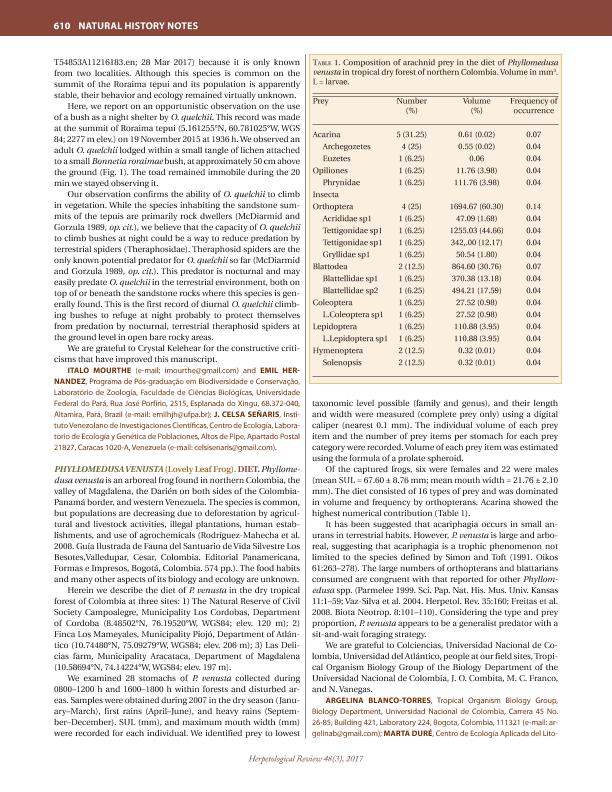Mostrar el registro sencillo del ítem
dc.contributor.author
Blanco Torres, Argelina

dc.contributor.author
Duré Pitteri, Marta Inés

dc.contributor.author
Bonilla, M. A.
dc.date.available
2022-10-13T10:48:21Z
dc.date.issued
2017-09
dc.identifier.citation
Blanco Torres, Argelina; Duré Pitteri, Marta Inés; Bonilla, M. A.; Phyllomedusa Venusta (Lovely Leaf Frog); Society for the Study of Amphibians and Reptiles; Herpetological Review; 48; 3; 9-2017; 610-611
dc.identifier.issn
0018-084X
dc.identifier.uri
http://hdl.handle.net/11336/172842
dc.description.abstract
PHYLLOMEDUSA VENUSTA (Lovely Leaf Frog). DIET.Phyllomedusa venusta is an arboreal frog found in northern Colombia, the valley of Magdalena, the Darién on both sides of the ColombiaPanamá border, and western Venezuela. The species is common, but populations are decreasing due to deforestation by agricultural and livestock activities, illegal plantations, human establishments, and use of agrochemicals (Rodríguez-Mahecha et al. 2008. Guía Ilustrada de Fauna del Santuario de Vida Silvestre Los Besotes,Valledupar, Cesar, Colombia. Editorial Panamericana, Formas e Impresos, Bogotá, Colombia. 574 pp.). The food habits and many other aspects of its biology and ecology are unknown. Herein we describe the diet of P. venusta in the dry tropical forest of Colombia at three sites: 1) The Natural Reserve of Civil Society Campoalegre, Municipality Los Cordobas, Department of Cordoba (8.48502°N, 76.19520°W, WGS84; elev. 120 m); 2) Finca Los Mameyales, Municipality Piojó, Department of Atlántico (10.74480°N, 75.09279°W, WGS84; elev. 206 m); 3) Las Delicias farm, Municipality Aracataca, Department of Magdalena (10.58694°N, 74.14224°W, WGS84; elev. 197 m). We examined 28 stomachs of P. venusta collected during 0800–1200 h and 1600–1800 h within forests and disturbed areas. Samples were obtained during 2007 in the dry season (January–March), first rains (April–June), and heavy rains (September–December). SUL (mm), and maximum mouth width (mm) were recorded for each individual. We identified prey to lowest taxonomic level possible (family and genus), and their length and width were measured (complete prey only) using a digital caliper (nearest 0.1 mm). The individual volume of each prey item and the number of prey items per stomach for each prey category were recorded. Volume of each prey item was estimated using the formula of a prolate spheroid. Of the captured frogs, six were females and 22 were males (mean SUL = 67.60 ± 8.76 mm; mean mouth width = 21.76 ± 2.10 mm). The diet consisted of 16 types of prey and was dominated in volume and frequency by orthopterans. Acarina showed the highest numerical contribution (Table 1). It has been suggested that acariphagia occurs in small anurans in terrestrial habits. However, P. venusta is large and arboreal, suggesting that acariphagia is a trophic phenomenon not limited to the species defined by Simon and Toft (1991. Oikos 61:263–278). The large numbers of orthopterans and blattarians consumed are congruent with that reported for other Phyllomedusa spp. (Parmelee 1999. Sci. Pap. Nat. His. Mus. Univ. Kansas 11:1–59; Vaz-Silva et al. 2004. Herpetol. Rev. 35:160; Freitas et al. 2008. Biota Neotrop. 8:101–110). Considering the type and prey proportion, P. venusta appears to be a generalist predator with a sit-and-wait foraging strategy.
dc.format
application/pdf
dc.language.iso
eng
dc.publisher
Society for the Study of Amphibians and Reptiles
dc.rights
info:eu-repo/semantics/openAccess
dc.rights.uri
https://creativecommons.org/licenses/by-nc-sa/2.5/ar/
dc.subject
Phyllomedusa Venusta
dc.subject
Diet
dc.subject
Colombia
dc.subject.classification
Otras Ciencias Biológicas

dc.subject.classification
Ciencias Biológicas

dc.subject.classification
CIENCIAS NATURALES Y EXACTAS

dc.title
Phyllomedusa Venusta (Lovely Leaf Frog)
dc.type
info:eu-repo/semantics/article
dc.type
info:ar-repo/semantics/artículo
dc.type
info:eu-repo/semantics/publishedVersion
dc.date.updated
2017-10-30T18:49:17Z
dc.journal.volume
48
dc.journal.number
3
dc.journal.pagination
610-611
dc.journal.pais
Estados Unidos

dc.description.fil
Fil: Blanco Torres, Argelina. Universidad Nacional de Colombia; Colombia
dc.description.fil
Fil: Duré Pitteri, Marta Inés. Consejo Nacional de Investigaciones Científicas y Técnicas. Centro Científico Tecnológico Conicet - Nordeste. Centro de Ecología Aplicada del Litoral. Universidad Nacional del Nordeste. Centro de Ecología Aplicada del Litoral; Argentina
dc.description.fil
Fil: Bonilla, M. A.. Universidad Nacional de Colombia; Colombia
dc.journal.title
Herpetological Review

dc.relation.alternativeid
info:eu-repo/semantics/altIdentifier/url/https://ssarherps.org/herpetological-review-pdfs/
Archivos asociados
